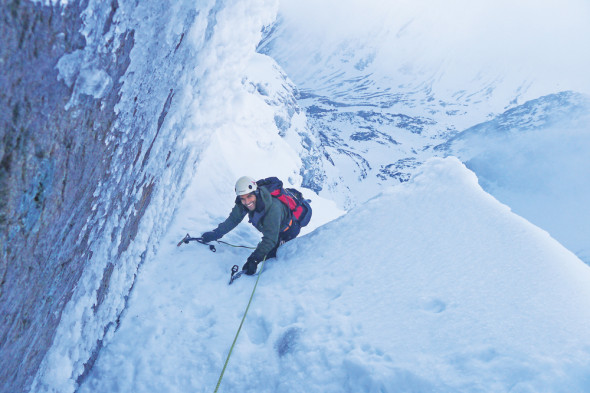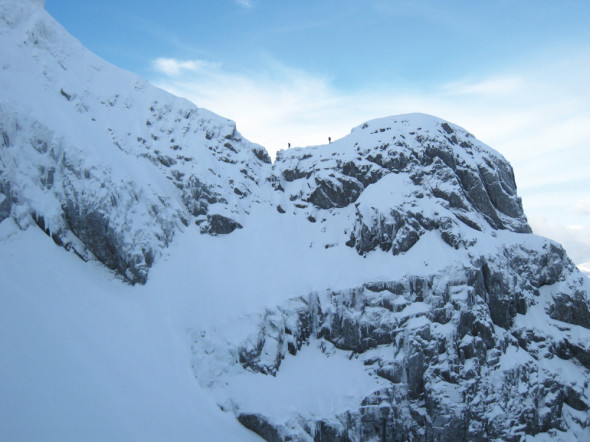British Mountain Guide James Thacker gives an overview of the routes that aspiring winter climbers could find themselves on…
Ben Nevis needs little in the way of introduction, being the highest mountain in the UK at 1344m above sea level. The winter climbing jewel in Scotland’s crown is an obvious target for winter warriors from around the world; with some of the highest cliffs in the UK and deep corries rising directly out of the sea, Ben Nevis suffers from savage weather producing some of the best ice anywhere. The complex nature of our biggest mountain means that there are always new and interesting routes to be discovered, many of which are hidden gems. With a ‘mini alpine’ scale, the mountain has a hefty history to match, having been the scene of ground-breaking routes for well over 100 years.
The unique ‘snow ice’ – or nevé – found on ‘The Ben’ is created when the moisture from the sea plates itself onto the mountain, making it rightly famous for not only ‘thin face’ climbing at the higher grades, but many classic routes which can be heavily plastered in the white stuff in good conditions.
The sheer scale of the mountain defines many people’s early visits to Ben Nevis – it simply feels bigger and better than anywhere you may have been before. What follows here is an attempt to describe some of the different areas and routes for those early visits to the mountain.
Carn Mor Dearg Arete
In good visibility the Carn Mor Dearg Arete (CMD to many) simply gives a superb view of the action. Here, late on in the season with plenty of daylight, the classic traverse (grade I) to the summit of Ben Nevis can be enjoyed with ample opportunity to see folk shivering in the shade of the North Face. Conditions vary considerably, but a good, consolidated snow cover is best for making rapid progress – rather than an early season dusting of fresh powder.
Most parties start from the North Face carpark, making an ascent over Carn Dearg Meadhonach and Carn Mor Dearg and onto Ben Nevis. Another hidden gem of the area is the East Spur of Carn Dearg Meadhonach which gives a wild and isolated ascent of grade I/II. This does have the advantage of being accessible from the Nevis Range gondola, giving a slightly different start to the lengthy traverse. But be warned it is long to carry onto the summit of Ben Nevis itself and will require favourable conditions. For the lucky it does give one of the finest big days out in Lochaber. Also worth noting is the nature of the final climb to the summit of Ben Nevis. This slope can be icy, and careful cramponing will pay significant dividends here as you are all too close to the sickening drop of the Little Brenva Face.
The Great Ridges
Like many climbers, my first visits to Ben Nevis were to climb the famous Great Ridges of North East Buttress, Observatory Buttress, Tower Ridge and Castle Ridge. Every one of the Great Ridges have different attributes, but all share the common theme of being long and commiting routes, their grades only telling part of the story.
My first foray onto this historic terrain was an attempt (you guessed it… it didn’t go well) on Tower Ridge. Starting early from the outskirts of Fort William, we made good progress towards the Douglas Boulder – apart from getting lost in the golf course, now thankfully avoided by the North Face carpark. Pleased with our efforts to be ahead of the crowds we climbed quickly upwards, only to find a tricky ice pitch. Eventually we negotiated the impasse only to find ourselves at the back of a massive queue. Route finding is an essential skill on such a big mountain and we were forced to descend having been taught our first lessons – check the route descriptions and start even earlier! We had been overtaken by lots of parties while taking our slightly more direct line.
A couple of years later on a quiet day I climbed Tower Ridge for the first time with James Edwards in good conditions. The 600m ridge took a fraction of the time but the bottlenecks and multiple tricky sections were all too evident. All the big ridges remain a significant mountaineering challenge and still see their fair share of benightments, not to mention rescues by Lochaber MRT. Before attempting these mammoth lines it’s essential to have mastered a range of rope techniques.
Recommended Ridges: Tower Ridge IV,3 (an unusual grade but testament to frequent epics), Castle Ridge III (but does pack a punch).
Read the rest of this article in the January 2014 edition of Trek & Mountain – BUY HERE



